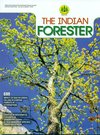Impact of Ban on Green Felling in Chirpine Forests of Uttarakhand
DOI:
https://doi.org/10.36808/if/2018/v144i8/132092Keywords:
Green Felling, Thinning, Regeneration, Phytodiversity, Soil Fertility, Chirpine, Uttarakhand.Abstract
A study was undertaken to assess the impact of the existing ban on green felling of trees in Chirpine (Pinus roxburghii) areas above 1,000 m altitude in Uttarakhand state, India. Crop composition, regeneration status and soil nutrients were studied for 374 sample plots in eleven forest divisions representing the entire ban-affected area of the species to analyse differences between felled coupes and control plots (un-felled forest where the prescribed felling could not be done due to ban).
On the expected lines, the control areas were found to have significantly higher proportion of very dense forests (54 per cent) than in treated areas (38 per cent). The number of total tree species in treated areas was more (34) than in the control areas (23). Chirpine was the dominant species from standpoint of tree density forming 80.96-100 per cent and 71.03-100 per cent of tree population in treated and control stands respectively. However, in Pithoragarh control areas, chirpine component has decreased from 86.27 per cent in treated areas to 71.03 in control areas. Treated areas had greater diversity of shrubs than the control areas. However, significant differences were not observed in IVI values of tree species in treated and control areas, except for Rhododendron arboreum which recorded significantly greater IVI for control area vis-Ã -vis treated area. Shrub species were found to have significantly higher IVI values in the control areas than in the treated areas thereby implying that weed species like Eupatorium spp., Ageratum conyzoides and Berberis asiatica have steadily gained space in the control areas.
Out of the 11 forest divisions where this study was conducted, regeneration in treated areas was good in one and fair in nine forest divisions while in control areas it was poor in eight forest divisions. Regeneration was absent in one forest division. Though seedlings of regeneration were recorded in control areas of seven forest divisions, saplings were absent. Soil fertility in treated areas was generally better than the control, thereby dispelling the fears that opening of canopy might lead to reduction in soil fertility.
References
Champion H.G. and Seth S.K. (1968). Forest Types of India. Govt. of India Publication, Calcutta.
Curtis J.T. and McIntosh R.P. (1950). The interrelations of certain analytic and synthetic phytosociological characters. Ecology, 31, 434-455.
Dangwal L.R. and Singh T. (2012). Comparative vegetational analysis and Pinus roxburghii Sarg regeneration in relation to their disturbances in some chirpine forest of block Nowshera, district Rajouri, J&K, India. ISCA Journal of Biological Sciences, 1(1): 47-54.
Dash M.C. (2001). Fundamentals of Ecology. Tata McGraw Hill Publishing Co. Ltd. New Delhi.
F.R.I. (2018). Study on impact of ban on green felling on biophysical status of forest in context to production prescribed in working plans vis-a-vis actual production from chir forests of Uttarakhand. Project Report, Forest Research Institute, Dehradun. 171 p.
F.S.I. (2015). India State of Forest Report, 2015. Forest Survey of India, Dehradun. 300 p.
Howard S.H. (19260. Yield and volume tables for chir (Pinus longifolia). Indian Forest Records. Silviculture Series. Part V, Vol. XII. Govt. of India, Central Publication Branch. 21+ x p.
Khan M.L., Rai J.P.N. and Tripathi R.S. (1987). Population structure of some tree species in disturbed and protected subtropical forests of North East India. Acta Oecologica - Oecologia Applicata, 8: 247-255.
Malik Z.A. and Bhatt A.B. (2016). Regeneration status of tree species and survival of their seedlings in Kedarnath Wildlife Sanctuary and its adjoining areas in Western Himalaya, India. Tropical Ecology, 57(4): 677-690.
Raunkiaer C. (1934). The Life forms of Plants and Statistical Plant Geography. Clarendon Press, Oxford, 639 p.
Seth S.K., Dabral S.N. and Kala M.K. (1972). Yield and stand tables for chir (Pinus) roxburghii, Sargent) high forest. Indian Forest Records (New Series) Silviculture. F.R.I and Colleges, Dehradun.
Shannon C.E. and Wiener W. (1963). The mathematical theory of communication, University of Illinois Press, Urbana.
Troup R.S. (1921). Silviculture of India Trees. Vol. III. Oxford Clarendon Press, London.
Downloads
Downloads
Published
How to Cite
Issue
Section
License
Unless otherwise stated, copyright or similar rights in all materials presented on the site, including graphical images, are owned by Indian Forester.





